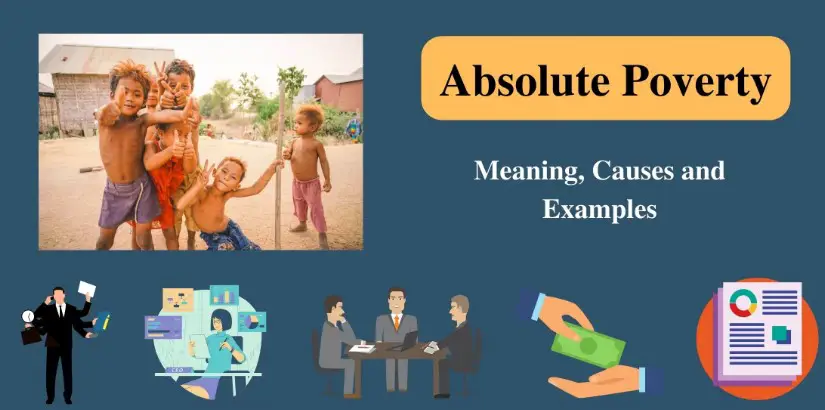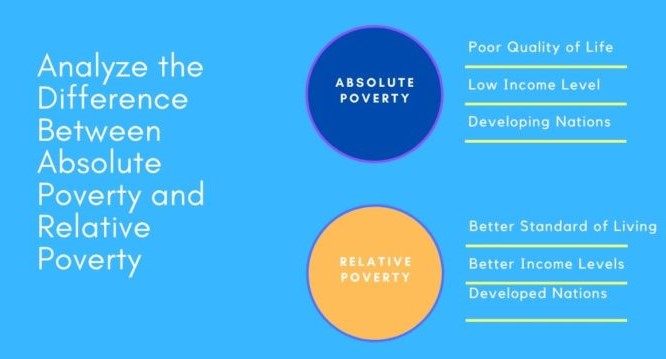Poverty is a complex issue that affects people both in the developed and developing world. While poverty is difficult to define, there are two main types of poverty: absolute poverty and relative poverty.
Definition of absolute poverty

Absolute poverty is defined as the inability to meet basic needs such as food, shelter, and clothing. It is measured directly by the lack of resources that a person or household has in order to survive. Relative poverty, on the other hand, is a measure of economic inequality in a given community.
Relative poverty, on the other hand, is a measure of economic inequality in a given community. It is the difference between the income of the poorest and the average income of a population. In other words, relative poverty is the comparison of how well the poorest people are doing compared to the rest of society.
Definition of relative poverty

Relative poverty is defined as an economic condition where individuals and households lack the resources necessary to meet a certain level of living standards and quality of life expected within a given society. It is typically measured as a percentage of median income. In comparison to absolute poverty, relative poverty is more dependent on factors such as the overall standard of living in a given country, the cost of living and the distribution of income and wealth.
In comparison to absolute poverty, relative poverty is more dependent on factors such as the overall standard of living in a given country, the cost of living and the distribution of income and wealth. Relative poverty is particularly relevant when discussing the poverty levels in developed countries as it takes into account the social and economic context in which poverty exists. This means that the same level of income can be considered poor in one country but not in another.
Explanation of the differences between absolute and relative poverty

Absolute poverty and relative poverty are two distinct concepts that are used to measure financial disadvantage. Absolute poverty is a fixed measure of poverty that is based on an individual or household’s income level compared to a predetermined poverty line.
It is determined by comparing a household’s income to the average income of all households in the same country or region. In other words, absolute poverty is a measure of an individual or household’s financial standing compared to a fixed standard, while relative poverty is a measure of poverty relative to the rest of the population.
Causes of absolute and relative poverty
Poverty is a complex issue that can be described in multiple ways. Generally speaking, poverty can be divided into two different categories: absolute poverty and relative poverty.
Relative poverty, on the other hand, is determined by comparing a person’s income to the average income of their society. If a person’s income is significantly lower than the average income of their society, they can be considered to be in relative poverty.
Both absolute and relative poverty have their own causes, such as economic inequality, a lack of education, and job loss. It is important to understand the differences between these two types of poverty in order to better combat it and provide necessary aid to those in need.
Effects of poverty on health and education
Poverty is a complex issue that affects a person’s health and access to education. It’s important to understand the difference between absolute and relative poverty when examining the effects of poverty on health and education. Absolute poverty refers to a lack of resources necessary to maintain a basic standard of living.
This can include a lack of access to food, shelter, clothing, and other basic needs. Relative poverty, on the other hand, measures a person’s relative position to others in society.
It looks at the gap between a person’s resources and the resources of the majority within a country. Both types of poverty have serious implications for health and education, as those living in poverty often face greater health risks and have reduced access to educational opportunities.
Final Touch
In conclusion, the differences between absolute and relative poverty are important to understand. Absolute poverty refers to a set level of income below which individuals cannot meet their basic needs while relative poverty is a measure of how an individual’s economic situation compares to the rest of society.
Absolute poverty is a more objective measure of poverty, as it accounts for the cost of basic needs in a given area, while relative poverty is more subjective and may vary from place to place. With an understanding of the distinction between these two types of poverty, governments and other organizations can better target poverty reduction strategies.

